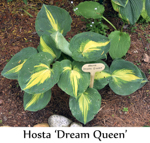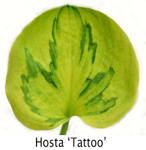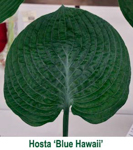|
 Hostas, like most plants,
reproduce in two ways. Sexual reproduction involves the
combination of pollen and egg to produce seeds while asexual reproduction
occurs when "spontaneous" changes occur in the tissue of
the plant causing it to change traits on some parts of the mother
plant. Sexual reproduction results in seeds and
seedlings while the other form produces what are called
"sports". Over time, certain hostas have been used often
in hybridizing programs to produce new cultivars while other hostas are noted for the production of sports. A few
have produced new introductions by both methods. Hostas, like most plants,
reproduce in two ways. Sexual reproduction involves the
combination of pollen and egg to produce seeds while asexual reproduction
occurs when "spontaneous" changes occur in the tissue of
the plant causing it to change traits on some parts of the mother
plant. Sexual reproduction results in seeds and
seedlings while the other form produces what are called
"sports". Over time, certain hostas have been used often
in hybridizing programs to produce new cultivars while other hostas are noted for the production of sports. A few
have produced new introductions by both methods.
 We have over 13,300 hosta
names in our database representing around 9,000 to
10,000 different plants. Many are listed as parentage
"unknown" meaning that nobody kept records of the
ancestry of that plant. For a large number of
open-pollinated seedlings, only the mother i.e. pod
parent has been identified. The mother plant of most sports
is commonly listed regardless of whether it was found in
the garden or generated in the tissue culture process of
propagation. We have over 13,300 hosta
names in our database representing around 9,000 to
10,000 different plants. Many are listed as parentage
"unknown" meaning that nobody kept records of the
ancestry of that plant. For a large number of
open-pollinated seedlings, only the mother i.e. pod
parent has been identified. The mother plant of most sports
is commonly listed regardless of whether it was found in
the garden or generated in the tissue culture process of
propagation.
As with most things
associated with hostas, there is a bit of confusion
involved in determining the background of many
cultivars. Hostas listed below have been named as either the mother
(pod parent or originator of the sport) or father
(pollen parent) or has been noted as being a plant in
the "background" of the cultivar. We have also included
plants that are listed only as a certain "type" such as
an H. 'Sieboldiana'-type.
 Perhaps the most
uncertain aspect of this topic is the origin of all
those "big blue" or, rather, blue-green hostas. I heard
a Registrar say one time that the vast majority of these
types of hostas come from H. 'Elegans' and H. 'Sieboldiana'.
Historically, these names have been used interchangeably
so we may not know if the ancestor is actually H.
'Sieboldiana' which was once considered a separate
species or its primary offspring, H. 'Elegans'.
H. 'Tokudama' also may come into the mix on
many of these plants. Perhaps the most
uncertain aspect of this topic is the origin of all
those "big blue" or, rather, blue-green hostas. I heard
a Registrar say one time that the vast majority of these
types of hostas come from H. 'Elegans' and H. 'Sieboldiana'.
Historically, these names have been used interchangeably
so we may not know if the ancestor is actually H.
'Sieboldiana' which was once considered a separate
species or its primary offspring, H. 'Elegans'.
H. 'Tokudama' also may come into the mix on
many of these plants. |



